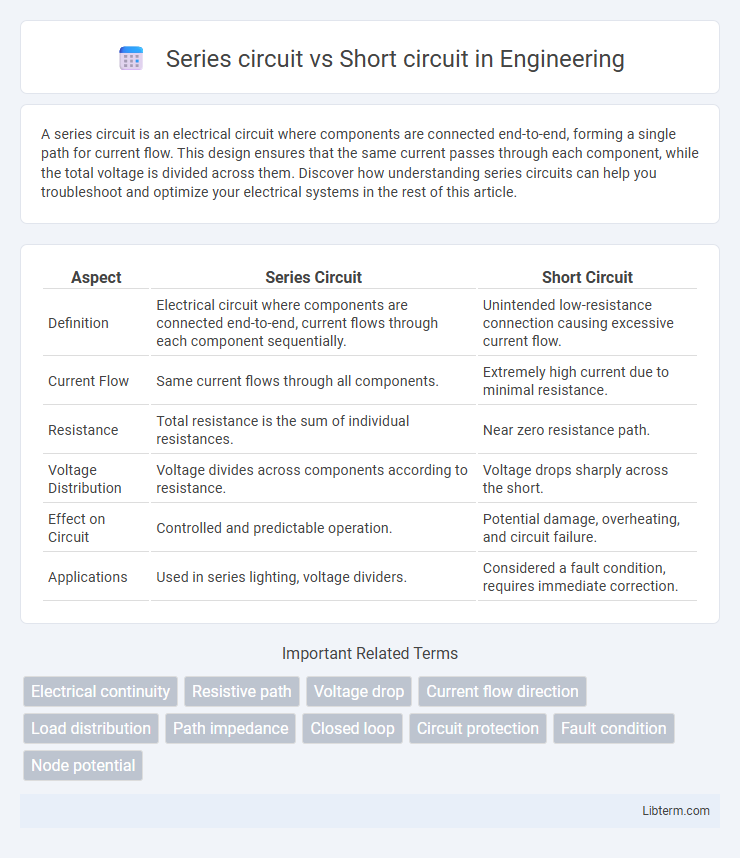A series circuit is an electrical circuit where components are connected end-to-end, forming a single path for current flow. This design ensures that the same current passes through each component, while the total voltage is divided across them. Discover how understanding series circuits can help you troubleshoot and optimize your electrical systems in the rest of this article.
Table of Comparison
| Aspect | Series Circuit | Short Circuit |
|---|---|---|
| Definition | Electrical circuit where components are connected end-to-end, current flows through each component sequentially. | Unintended low-resistance connection causing excessive current flow. |
| Current Flow | Same current flows through all components. | Extremely high current due to minimal resistance. |
| Resistance | Total resistance is the sum of individual resistances. | Near zero resistance path. |
| Voltage Distribution | Voltage divides across components according to resistance. | Voltage drops sharply across the short. |
| Effect on Circuit | Controlled and predictable operation. | Potential damage, overheating, and circuit failure. |
| Applications | Used in series lighting, voltage dividers. | Considered a fault condition, requires immediate correction. |
Understanding Series Circuits
Series circuits consist of components connected end-to-end, creating a single path for current flow, which means the same current passes through each component. Voltage divides across components proportionally to their resistance, following Ohm's Law (V=IR), enabling straightforward calculation of total resistance as the sum of individual resistances. Understanding series circuits is essential for troubleshooting, as a break anywhere in the circuit stops current flow, distinguishing them clearly from short circuits where unintended low-resistance paths cause excessive current flow.
What Defines a Short Circuit?
A short circuit occurs when an unintended low-resistance path connects two points in an electrical circuit, bypassing the designed load and causing excessive current flow. This sudden surge can result in overheating, damage to components, or fire hazards due to the circuit's inability to regulate the current properly. In contrast, a series circuit has components connected end-to-end, ensuring current flows through each element sequentially without the risk of a short circuit.
Key Differences Between Series and Short Circuits
A series circuit features components connected end-to-end, allowing current to flow through each element sequentially with a single path, while a short circuit occurs when an unintended low-resistance path bypasses one or more components, causing excessive current flow. The key difference lies in the series circuit's controlled current flow and voltage drops across components, contrasted with a short circuit's excessive current and potential damage to the circuit. Series circuits maintain functionality and predictable behavior, whereas short circuits pose safety hazards, often triggering circuit breakers or fuses to prevent overheating and fires.
Electrical Flow in Series Circuits
In a series circuit, electrical flow follows a single path where current remains constant through all components, ensuring uniform voltage drops across each element. In contrast, a short circuit creates an unintended low-resistance path that drastically increases current flow, potentially causing circuit damage or failure. Understanding the controlled current flow in series circuits is crucial to preventing the dangerous effects of short circuits in electrical systems.
Causes and Consequences of Short Circuits
Short circuits occur when an unintended low-resistance path bypasses the designed circuit, often caused by damaged insulation, faulty wiring, or conductive debris creating a direct connection between two points. This results in a sudden surge of current that exceeds normal operating levels, leading to overheating, potential fires, and damage to electrical components such as circuit breakers and transformers. Understanding the causes and consequences of short circuits is critical for implementing protective measures like fuses, circuit breakers, and proper insulation to ensure electrical safety and equipment longevity.
Common Applications of Series Circuits
Series circuits are widely used in applications such as Christmas tree lights, where the same current flows through each bulb, ensuring uniform brightness. They are also common in fuse protection systems, where a single path allows current flow and opens the circuit if a fault occurs. This simplicity makes series circuits ideal for devices requiring sequential operation or current monitoring.
Dangers Associated With Short Circuits
Short circuits pose significant dangers including intense heat generation, which can cause fires or damage electrical components, and rapid current surges that may lead to electrical shocks or equipment failure. Unlike series circuits, where current flows through a predetermined path, short circuits create an unintended low-resistance path, resulting in excessive current flow. Immediate protective measures like circuit breakers or fuses are essential to prevent catastrophic hazards associated with short circuits.
How to Prevent Short Circuits
Preventing short circuits involves ensuring proper insulation of wires and secure connections to avoid unintended contact between conductive materials. Using circuit breakers and fuses provides an automatic disconnection during current overloads, protecting the series circuit from damage. Regular inspection and maintenance of electrical components help identify wear or faults that could lead to short circuits in series circuit setups.
Troubleshooting Problems in Series Circuits
In troubleshooting problems in series circuits, detecting a short circuit is essential because it causes excessive current flow, leading to component damage and circuit failure. A series circuit's unique characteristic of having the same current throughout means that a single fault, such as a short circuit or an open circuit, disrupts the entire circuit operation. Using a multimeter to check voltage drops and continuity helps identify shorts by pinpointing unintended paths of low resistance within the series wiring.
Series Circuit vs Short Circuit: Safety Considerations
Series circuits maintain controlled current flow through each component, reducing the risk of overheating and fire hazards. Short circuits create a low-resistance path, causing excessive current that can damage wiring, components, and pose serious safety risks. Proper circuit design and protective devices like fuses and circuit breakers are essential to prevent short circuit dangers in electrical systems.
Series circuit Infographic

 libterm.com
libterm.com